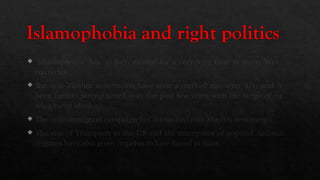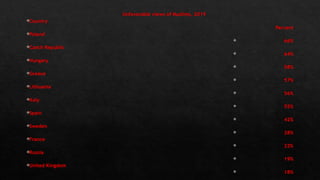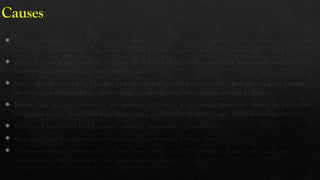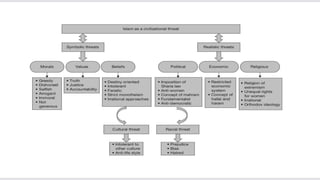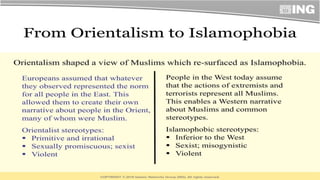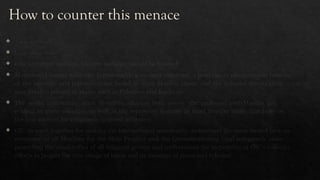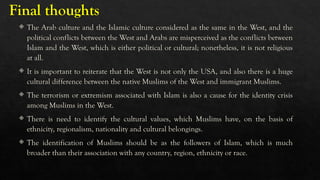Islamophobia: history and current scenario plus suggestions and solution.
- 3. ’é▒The term ŌĆśIslamophobiaŌĆÖ has been used in abundance since the release of the Runnymede report in 1997, and more so after the 9/11 tragedy. ’é▒The phenomenon of Islamophobia is historic in nature. This has been there since the birth of Islam in the early 7th century ’é▒Islamophobia has not been defined in a systematic and scientific fashion in literature; rather efforts have been made to include all negativities in its ambit without substantiating it with cogent rationale.
- 4. ’é▒Islamophobia is not a monolithic bloc or phenomenon, but a construct having multiple facets/dimensions. ’é▒The literature on Islamophobia seems to have been produced in haste; hence, inundated with countless glitches. ’é▒ OrientalistŌĆÖs perspective on Islamophobia has mostly driven the debates and definitions of Islamophobia, which is not more than a mere fab. ’é▒Antecedents of Islamophobia are less debated in literature; if exist, they are mostly impressionistic and not scientific.
- 5. ’é▒ Islamophobia has often been discussed and debated in literature as a qualitative phenomenon. ’é▒ Less efforts have been made in explicating Islamophobia as a concept and making it operational for the purpose of quantitative measurement. ’é▒ In terms of its antecedents, Islamophobia at various places is not the same in nature; however, its manifestations are similar. ’é▒ Contemporary Islamophobia has genesis in its mediated constructionŌĆō mediated Islamophobia. ’é▒ There are huge doubts on the first use of term Islamophobia in contemporary and most cited literature.
- 6. Additionally, there are some long-lived myths about Islamophobia, which are as follows: ’é▒ Myth 1: Islamophobia is a European hostility and is prejudice towards Arabo-Muslim people (Said, 1978). ’é▒ Myth 2: Islamophobia came into existence as a new enemy to the West after the demise of communism (Huntington 1993). ’é▒ Myth 3: Islamophobia is directed towards Muslims and not Islam.
- 8. A brief history of islamophobia ’é▒ 7th century ’é▒ 8th century ’é▒ Defeat of byzantine empire by ottomans ’é▒ True religion vs false religion ’é▒ Secularization ’é▒ 1911 ’é▒ The world got busy in communism vs liberalism ’é▒ The onslaught of Samuel P Hungtin ’é▒ 9/11 incident ’é▒ Post 2010 era ’é▒ The rise of global right wing politics ’é▒ NEW ZEALAND , Canada and India
- 9. A misperceived notion ’é▒Racism ’é▒Components of Racisms ’é▒Muslimism ’é▒What actually it is? ’é▒A hollow slogan
- 10. The Runnymede report contrasted "open" and "closed" views of Islam, and stated that the following "closed" views are equated with Islamophobia:[81] 1. Islam is seen as a monolithic bloc, static and unresponsive to change. 2. It is seen as separate and "other". It does not have values in common with other cultures, is not affected by them and does not influence them. 3. It is seen as inferior to the West. It is seen as barbaric, irrational, primitive, and sexist. 4. It is seen as violent, aggressive, threatening, supportive of terrorism, and engaged in a clash of civilizations. 5. It is seen as a political ideology, used for political or military advantage. 6. Criticisms made of "the West" by Muslims are rejected out of hand. 7. Hostility towards Islam is used to justify discriminatory practices towards Muslims and exclusion of Muslims from mainstream society. 8. Anti-Muslim hostility is seen as natural and normal.
- 11. Islamophobia and right politics ’é▒ ŌĆśIslamophobiaŌĆÖ has, in fact, existed for a very long time in many Western countries. ’é▒ But anti-Muslim movements have seen a marked rise after 9/11 and have been further strengthened over the past few years with the surge of right- wing racist ideology. ’é▒ The anti-immigrant campaign has intensified anti-Muslim sentiments. ’é▒ The rise of Trumpism in the US and the emergence of populist nationalist regimes have also given impetus to hate-based politics.
- 12. Unfavorable views of Muslims, 2019 ’é▒Country Percent ’é▒Poland ’é▒ 66% ’é▒Czech Republic ’é▒ 64% ’é▒Hungary ’é▒ 58% ’é▒Greece ’é▒ 57% ’é▒Lithuania ’é▒ 56% ’é▒Italy ’é▒ 55% ’é▒Spain ’é▒ 42% ’é▒Sweden ’é▒ 28% ’é▒France ’é▒ 22% ’é▒Russia ’é▒ 19% ’é▒United Kingdom ’é▒ 18%
- 13. Causes ’é▒ Blemished understanding of Muslims and Islam had roots in history fraught with inimical relations eclipsed by long wars (crusades) between the binary religious forces fortified the notion of orientalismŌĆöŌĆśusŌĆÖ and ŌĆśthemŌĆÖ ’é▒ political as well as economic reasons for the rise of the anti-immigrant movement particularly in Europe that often takes an anti-Muslim turn. ’é▒ Some violent actions by Muslim individuals influenced by extremist ideology too have been used by racist and ultra-right groups to whip up anti-Muslim sentiments as seen in France. ’é▒ Terms, like ŌĆśIslamic terrorismŌĆÖ are used in right-wing propaganda literature. Surely in some cases the stateŌĆÖs policy of cultural discrimination has also contributed to anti-Muslim sentiments. ’é▒ Islam as a stumbling block against western hegemonyŌĆō globalization ’é▒ West as ŌĆśusŌĆÖ and the other side was defined as the orientŌĆöthe East or ŌĆśthem ’é▒ mainstream news channels such as Fox News, NBC and CBS portrayed Islam as a major violence and militancy triggering ideology in their news coverage during 2007 and 2013
- 16. How to counter this menace ’é▒ 2 way approach ’é▒ Look inside first ’é▒ hate literature and anti-Muslim websites should be banned ’é▒ Moreover, Islamist militancy is thoroughly a modern construct, a reactionary phenomenon born out of the injustice and repressiveness found in most Muslim states, and the colonial interventions of non-Muslim powers in places such as Palestine and Kashmir. ’é▒ The world community must therefore address both issues: the profound anti-Muslim prejudice evident in many societies, as well as the repressive systems in most Muslim states that help create the foot soldiers for religiously inspired militancy. ’é▒ OIC to work together for making the international community understand the deep-rooted love and reverence of all Muslims for the Holy Prophet and the Quraninstituting legal safeguards aimed at protecting the sensitivities of all religious groups and underscored the imperative of OICŌĆÖs collective efforts to project the true image of Islam and its message of peace and toleranc
- 17. Final thoughts ’é▒ The Arab culture and the Islamic culture considered as the same in the West, and the political conflicts between the West and Arabs are misperceived as the conflicts between Islam and the West, which is either political or cultural; nonetheless, it is not religious at all. ’é▒ It is important to reiterate that the West is not only the USA, and also there is a huge cultural difference between the native Muslims of the West and immigrant Muslims. ’é▒ The terrorism or extremism associated with Islam is also a cause for the identity crisis among Muslims in the West. ’é▒ There is need to identify the cultural values, which Muslims have, on the basis of ethnicity, regionalism, nationality and cultural belongings. ’é▒ The identification of Muslims should be as the followers of Islam, which is much broader than their association with any country, region, ethnicity or race.
- 18. QA?
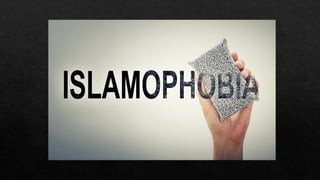
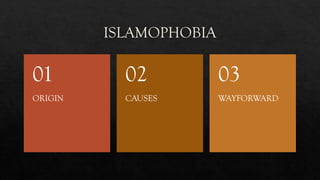
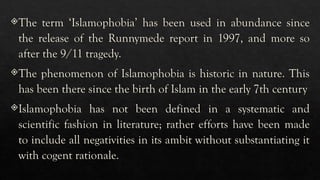
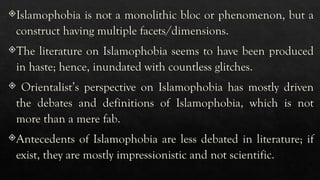
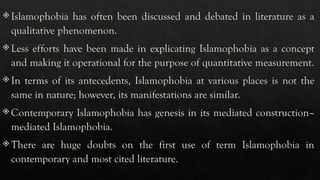
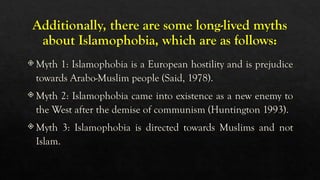
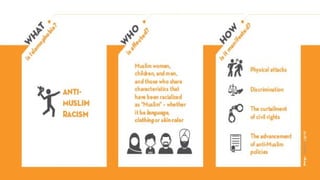
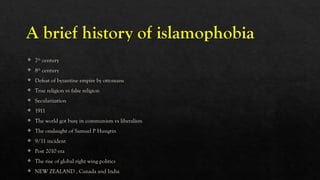
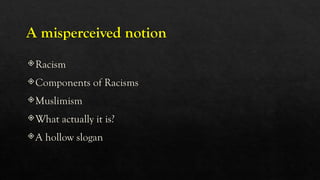
![The Runnymede report contrasted "open" and "closed"
views of Islam, and stated that the following "closed"
views are equated with Islamophobia:[81]
1. Islam is seen as a monolithic bloc, static and unresponsive to change.
2. It is seen as separate and "other". It does not have values in common
with other cultures, is not affected by them and does not influence them.
3. It is seen as inferior to the West. It is seen as barbaric, irrational,
primitive, and sexist.
4. It is seen as violent, aggressive, threatening, supportive of terrorism, and
engaged in a clash of civilizations.
5. It is seen as a political ideology, used for political or military advantage.
6. Criticisms made of "the West" by Muslims are rejected out of hand.
7. Hostility towards Islam is used to justify discriminatory practices
towards Muslims and exclusion of Muslims from mainstream society.
8. Anti-Muslim hostility is seen as natural and normal.](https://image.slidesharecdn.com/islamophobia-250317195621-f73efa82/85/Islamophobia-history-and-current-scenario-plus-suggestions-and-solution-10-320.jpg)
